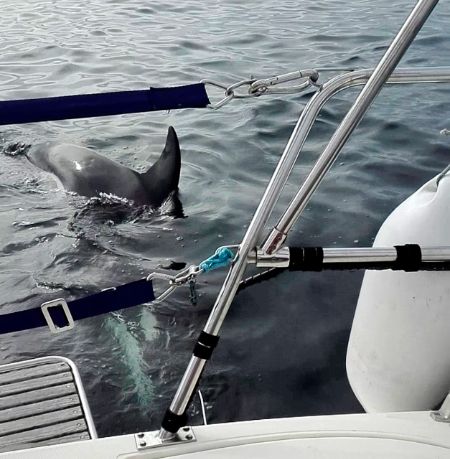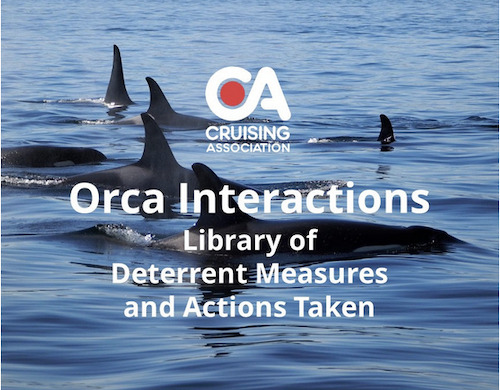Straits of Gibraltar: Yacht Sinks after Orca Interaction
In the latest incident, which occured on October 31, a pod of Orcas targeted a yacht in the Straits of Gibraltar for about 45 minutes, which ultimately caused it to sink. All crew were rescued.
Published 1 year ago, updated 12 months ago
Cases of orcas harassing yachts sailing through the Straits of Gibraltar (which runs between Spain and Morocco and connects the Atlantic Ocean to the Mediterranean Sea), began being reported in 2020. This is the fourth yacht, to date, that has sunk following such an interaction.
In a Facebook post on 31 October 2023, Morskie Mile said “the relentless attack focused on the yacht’s steering fin and caused extensive damage and leakage”.
“Despite attempts to bring the yacht to the port by the captain, crew and rescuers from the SAR (Search and Rescue), port tugs and the Moroccan Navy, the yacht ‘Grazie Mamma’ sank near the entrance to the port of Tanger Med,” the company said, while adding that the crew was “safe, unharmed, and sound”.
The Moroccan Navy towed the boat to safety, but it sank as it entered the port of Tanger-Med. The orcas hit the rudder with such force that it split the hull and the boat took on too much water.
This incident is the latest reported case of orcas targeting boats off Gibraltar – a phenomenon that has intrigued animal behaviour scientists. Some theorise that the killer whales may be teaching each other to target boats passing by in the region. Researchers have floated a number of theories to explain the behaviour of the aquatic mammals ranging from food scarcity and the disruptive resumption of post-pandemic nautical activities, to playful interactions.
However, scientists have also begun to investigate whether the Gibraltar attacks are linked to past-trauma.


Cruising Association Orca Reports
In 2022 the Cruising Association (CA) formed a collaboration with Grupo Trabajo Orca Atlantica (GTOA), a group of Spanish and Portuguese scientists who have been studying the behaviour of the Orcas for some years and who had provided advice in respect of this problem since 2020.
Since then, the CA have been compiling both eventful and uneventful passage reports from sailors in the areas, but says it does not currently have enough reports to make definitive conclusions from comparing the interaction and uneventful passage reports.
However, it says the following patterns are worth noting:
- Depth/distance offshore: Only one of the first 100 reports related to an interaction occurring in a water depth of up to 20m and anecdotal evidence from social media sources would seem to support this statistic. A review of the comparative data suggests there may be a reduced risk of experiencing an interaction within two miles of shore and in less than 40m water depth. This will be monitored as further reports are received. Sailing close to shore in shallower water may add risk to a passage, especially in the event of an interaction disabling the boat. The effects of wind and swell direction and tide on a disabled yacht and proximity to maritime rescue services should be considered when planning a passage close to shore.
- Antifoul colour: The comparative data seems to suggest that black antifoul may increase the impact of an interaction and that copper antifouling may reduce that. However, there is no scientific reasoning to support this possibility and report numbers to date do not make this a statistically significant finding.
- Autopilot: On social media, advice is often shared suggesting to turn off the depth sounder and autopilot to avoid attracting orcas with the noises emitted. The CA is monitoring the data for autopilot use to see if a pattern is appearing that may suggest using an autopilot could even reduce the risk of an interaction. This is not very statistically significant but it is possible that the noise of certain types of autopilot may act as a deterrent to certain orcas. Often the first knowledge a crew has of an orca interaction is feeling an impact to the rudder, which could damage the autopilot. Skippers must decide whether to use the autopilot based upon the small and unproven interaction risk reduction suggested by the emerging reported data.
- Daylight conditions: There are reports of interactions both during day and night. The statistics suggest, without a satisfactory level of statistical significance, that the chance of an interaction is marginally lower at night. However, if an interaction happens at night, a rescue will be more difficult and there will likely be fewer fishing and leisure craft in the area to assist a stricken yacht. Other differences are present between interaction and uneventful passage data, but more reports are required to indicate that those and the factors mentioned above are statistically significant.
Reporting interactions
The CA continues to ask all skippers to place a report with the CA’s central reporting portal, even if they also provide information on orca interactions or uneventful passages to different social media platforms.
The CA reporting portal is considered the central platform to monitor in detail orca interactions and uneventful passages and all anonymised reports and data summaries are accessible by all members of the public and the scientific community.


……………………………………….
Related News:
- Orcas Sink Another Yacht Near Gibraltar (The Independent)
- Orcas Attack Polish Yacht (Insider)
- Orcas Sink Another Boat in Europe (Live Science)
- A Pod of Orcas has Sunk a Yacht in the Straits of Gibraltar (NPR)
……………………………………….
Related Links:
- Cruising Association Orca Interaction Report Form
- Cruising Association Uneventful Passage Report Form
- Cruising Association Orcas Interaction Page
- Grupo Trabajo Orca Atlantica (GTOA)
- Noonsite Cruising Resources: Orcas and Yachts
- Orca Attack Reports Facebook group
……………………………………….
Find out all news, reports, links and comments posted on Noonsite, plus cruising information from around the world, by subscribing to our FREE monthly newsletter. Go to https://www.noonsite.com/newsletter/.
Related to following destinations: Atlantic Coast (Morocco), Atlantic Coast (Portugal), Gibraltar, Gibraltar Port, Morocco, Portugal
Related to the following Cruising Resources: Atlantic Crossing, Atlantic Ocean East, Incident Reports, Mediterranean, Orcas and Yachts, Routing, Safety, Safety and Medical





